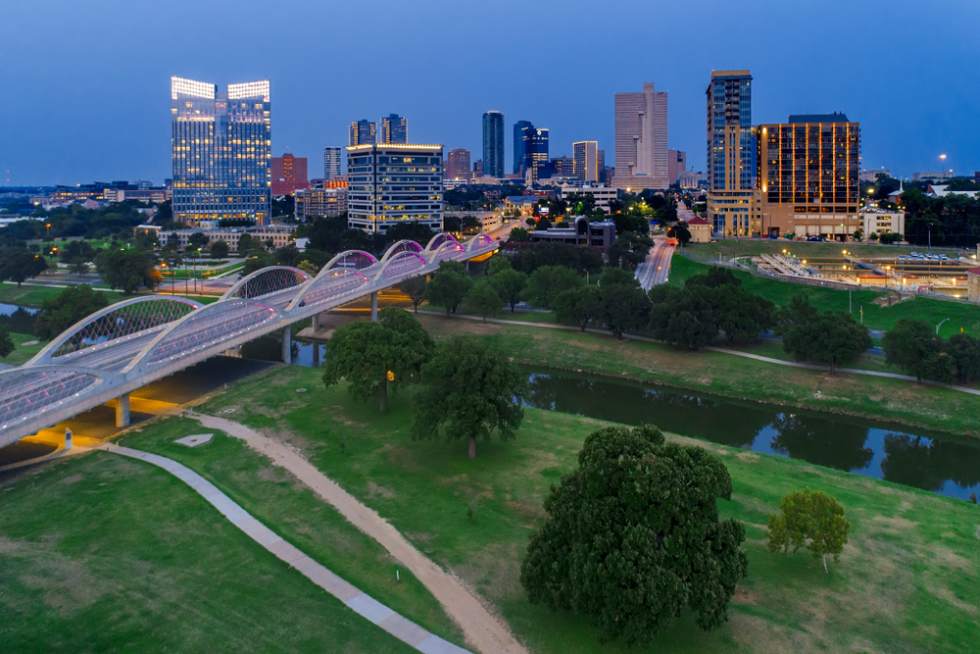South Bank at Quarry Trails
- 91 units available
- Studio • 1 bed • 2 bed • 3 bed
- Amenities
In unit laundry, Patio / balcony, Granite counters, Pet friendly, Stainless steel, Walk in closets + more

Fort Worth continues to attract new residents in 2025 with its affordable lifestyle, mild winters, and growing job market. Known for its blend of modern development and laid-back charm, the city offers easy access to major employers, outdoor trails, live music venues, and a steady stream of new restaurants and apartment builds.
Unlike larger metros that come with steep rent or dense traffic, Fort Worth gives you room to breathe, without sacrificing access to culture or opportunity.
Compared to pricier cities like Austin, Dallas, or Los Angeles, Fort Worth offers noticeable savings in housing, utilities, and day-to-day expenses. While the average rent for a two-bedroom apartment in Fort Worth is about $1,785, similar housing in Dallas averages over $2,100, and in LA, you’ll pay nearly twice that. Even with inflation and rising housing costs nationwide, Fort Worth remains one of the more accessible large cities for renters, families, and remote workers alike.
In the sections below, we’ll break down what it really costs to live in Fort Worth today, from housing and groceries to healthcare and transportation, so you can decide if the city fits your lifestyle and budget in 2025.
Fort Worth is a major metropolitan hub in North Texas and offers a lower-cost lifestyle than many U.S. cities of its size. On average, it’s about 4% cheaper than the national average, despite being slightly above the broader Texas average. Housing expenses, such as rent and mortgage, run around 13% below national norms, making living here more accessible even if you're working remotely or managing a smaller budget.
Within Fort Worth, cost varies by neighborhood. According to our latest data, Areas like Downtown Fort Worth and the Cultural District charge higher rents, often in the $1,300‑$2,200 range for a two-bedroom, but reward residents with walkability and transit access.
In contrast, neighborhoods such as Wedgwood, Candleridge, and Far Southwest offer rents closer to $1,200 for similar floor plans. Though transportation costs are slightly lower than the national average, owning a car remains essential in many parts of the city.
| Cost of Living / Category | City | State | U.S. |
|---|---|---|---|
| Overall | 101.5 | 94.2 | 100 |
| Grocery | 97.7 | 93.7 | 100 |
| Health | 99.3 | 100.0 | 100 |
| Housing | 86.5 | 83.5 | 100 |
| Median Home Cost | $306,700 | $297,600 | $338,100 |
| Utilities | 100.5 | 99.2 | 100 |
| Transportation | 113.9 | 103.3 | 100 |
| Miscellaneous | 109.2 | 83.2 | 100 |
Plano has the highest cost of living near Forth Worth, TX,, with two-bedroom rents averaging $1,948/month, over 31% higher than the Texas average and above the national median.
| Cost of Living / Category | Neighborhood | State | U.S. |
|---|---|---|---|
| Overall | 111.7 | 94.2 | 100 |
| Grocery | 103.0 | 93.7 | 100 |
| Health | 101.0 | 100.0 | 100 |
| Housing | 141.4 | 83.5 | 100 |
| Median Home Cost | $492,000 | $297,600 | $338,100 |
| Utilities | 100.4 | 99.2 | 100 |
| Transportation | 88.0 | 103.3 | 100 |
| Miscellaneous | 102.4 | 83.2 | 100 |
Lancaster is one of the most affordable places to live near Fort Worth, with one-bedroom rents averaging just $1,211 and two-bedrooms at $1,450. That puts a one-bedroom apartment at roughly 6.41% above the national average and well under the city average.
| Cost of Living / Category | Neighborhood | State | U.S. |
|---|---|---|---|
| Overall | 100.2 | 94.2 | 100 |
| Grocery | 96.6 | 93.7 | 100 |
| Health | 98.1 | 100.0 | 100 |
| Housing | 77.6 | 83.5 | 100 |
| Median Home Cost | $206,400 | $297,600 | $338,100 |
| Utilities | 99.6 | 99.2 | 100 |
| Transportation | 122.0 | 103.3 | 100 |
| Miscellaneous | 107.3 | 83.2 | 100 |
As of August 2025, the median rent in Fort Worth is $1,363, based on data from Apartment List. The one-bedroom median rent is $1,164, while two-bedroom units come in at $1,343.
Rents increased by 0.4% over the past month but remain 1.1% lower than this time last year, a slower decline than both the Texas statewide average (-2.7%) and the national average (-0.8%).
Despite recent volatility, overall Fort Worth rent prices are 2.8% below the national median and roughly 5.9% lower than the broader Dallas metro. That makes Fort Worth more affordable than many comparable cities and puts it on par with places like Reno, NV and Durham, NC.
Rent growth in 2025 has also outpaced 2024. From January through July, rents have risen 2.8% citywide, compared to just 1.0% growth in the same period last year. Fort Worth now ranks #61 among the 100 largest U.S. cities for rental costs, well below high-cost metros like Austin, Los Angeles, or San Francisco.
For City Only:
| Bedroom | Median Price |
|---|---|
| Overall | $1,363 |
| 1-Bedrooms | $1,164 |
| 2-Bedrooms | $1,343 |
For States Only:
| City | Median 1-Bedroom Rent | Median 2-Bedroom Rent |
|---|---|---|
| Dallas, TX | $1,217 | $1,481 |
| Durham, NC | $1,196 | $1,393 |
| Reno, NV | $1,127 | $1,410 |
As of mid-2025, the average rent for a one-bedroom apartment in Fort Worth is $1,399. Prices vary widely by neighborhood.
Downtown units often start around $1,700, while more affordable areas like Central Meadowbrook or Wedgwood can dip below $1,000. Rent may fluctuate depending on location, building age, and amenities like in-unit laundry or parking.
| Area | Rent |
|---|---|
| Overall | $1,399 |
| Downtown | $1,744 |
| Arlington Heights | $1,135 |
| Fairmount | $900 |
The average rent for a two-bedroom apartment in Fort Worth is $1,785 as of August 2025.
Higher-demand areas like Downtown and TCU–Westcliff often start above $2,000, while more budget-friendly neighborhoods such as Fairmount, Candleridge, or Far Southwest offer two-bedrooms closer to $1,200–$1,300.
Final pricing depends heavily on location, square footage, and building features like covered parking or on-site fitness centers.
| Area | Rent |
|---|---|
| Overall | $1,785 |
| Downtown | $2,227 |
| Arlington Heights | $1,452 |
| Fairmount | $1,787 |
Fort Worth housing remains relatively accessible compared to other major metros. While high-end properties exist, the median home price in Fort Worth is around $355,000 as of mid-2025. That’s well below the national median of $436,000, making it a more attainable market for renters considering a future move into homeownership.
With steady new construction in outer neighborhoods and moderate price growth year-over-year, Fort Worth continues to offer entry points for buyers who might be priced out in places like Austin or Dallas.

A common rule of thumb for housing affordability is the 30% rule, meaning you should spend no more than 30% of your gross income on rent. Based on an average one-bedroom rent of $1,399, you’d need to earn at least $55,960 per year, or $4,663 per month, to stay within the 30% income rule. That breaks down to about $26.90 per hour for a full-time worker. If you’re targeting a two-bedroom at the average $1,785, the required income jumps to $71,400 per year.
According to the U.S. Census Bureau, Fort Worth’s median household income is $76,602, slightly below the national median of $78,538. This puts the average Fort Worth renter just under the 30% rule for a two-bedroom and well within range for a one-bedroom.
That said, expenses beyond rent, like utilities, groceries, and transit. can add up. For a quick estimate of what fits your budget, try our Apartment List Rent Calculator to explore options based on your income.
For those seeking a more detailed benchmark, the MIT Living Wage Calculator estimates that a single adult in Fort Worth needs to earn $23.86 per hour just to cover basic needs like food, housing, and healthcare. However, that number does not account for savings, travel, or debt repayments, making it a baseline, not a comfort zone.
With MIT’s Living Wage Calculator data, we can see typical transportation expenses for different household types in the Dallas–Fort Worth region:
| Household Type | Annual Transportation Cost | Monthly Breakdown |
|---|---|---|
| Single Adult (no children) | $10,208 | ~$850 per month |
| Dual-income household with two children | $17,123 | ~$1,426 per month |
Fort Worth remains overwhelmingly car-dependent. Over 76% of residents drive alone to work. Traffic congestion can build during peak periods on I-35W, I-820, and I-30. Public transit infrastructure is improving slowly, with the Trinity Metro running dozens of bus lines and TEXRail connecting to DFW Airport,, but service frequency and coverage remain limited compared to larger cities.
In terms of walkability, Walk Score data highlights certain Fort Worth neighborhoods where being car-free is realistic:
If daily transit matters and car ownership isn’t ideal, these areas provide the greatest flexibility for getting around the city, especially when paired with moderate transit expenses.
According to MIT’s Living Wage Calculator, a single adult in the Dallas–Fort Worth metro area typically spends $4,021 per year on food, while a two-adult household with two children averages $11,786 per year. That breaks down to about $335/month for a solo renter and $982/month for a small family, covering groceries and basic meals at home.
Dining out in Fort Worth remains relatively affordable. According to Numbeo, an average meal at an inexpensive restaurant costs around $16, while a three-course dinner for two at a mid‑range spot averages around $60. Local favorites like tacos at a food truck or a plate at a casual Tex-Mex spot can run under $10, helping keep meal costs down.
If you enjoy eating out regularly or order delivery, expect higher monthly food costs. Neighborhoods like Southside, Downtown, or the Cultural District offer plenty of dining options, though non‑cooking habits can push your food spend well over federal averages.
Families face notable child care expenses in the Fort Worth area. According to MIT’s Living Wage data for the Dallas–Fort Worth metro, a single working adult with one child can expect childcare costs of approximately $10,249 per year. For households with two working adults and two children, annual child care costs rise to around $20,190.
That means childcare alone can exceed $850/month for one child, and nearly $1,700/month for two. These figures form a significant part of the living wage calculation for local parents and should factor into budgeting decisions.
Parents looking to reduce these costs have options: working from home part-time or staggering shifts can reduce reliance on full-day care. Exploring neighborhoods with lower rent, such as Central Meadowbrook, Wedgwood, or Candleridge, might free up budget room.
Additionally, opening a Child Care Development Fund (CCDF) voucher or joining cooperative/home-based care waitlists early can help manage costs more effectively.
Using data from the MIT Living Wage Calculator (Dallas–Fort Worth–Arlington metro), a single adult typically spends around $3,094 per year on healthcare, including insurance premiums and out-of-pocket costs. For a family of two working adults and two children, healthcare expenses rise to approximately $10,025 annually.
Healthcare costs are a considerably higher share of the budget in families, making basic medical care one of the largest recurring expenses after housing and food.
A typical Fort Worth apartment (roughly 915 sq. ft) has monthly utility costs (electricity, heating/cooling, water, garbage) of around $230.48, which is approximately 15–17% higher than the national average.
On top of that, a mobile phone plan (≈10 GB + voice) averages $90.71/month, while high-speed internet (60 Mbps or more, unlimited) runs about $78.75/month, putting Fort Worth slightly above the national norm for telecom costs.
Fort Worth’s hot summers and occasional cold snaps drive seasonal spikes in electricity usage, especially June through September, so budgeting extra during those months is wise. Neighborhoods like Downtown Fort Worth, Southside, and the Cultural District may benefit from newer building stock and energy-efficient systems, which can help temper monthly costs in densely developed areas.
Fort Worth offers plenty of affordable ways to stay active or have fun, whether that means exploring trails, watching a movie, or skipping the gym altogether.

Fort Worth includes over 11,700 acres of parkland across 263 parks, including highlights like the Fort Worth Water Gardens downtown, the expansive Trinity Trails, and the Fort Worth Nature Center & Refuge in northwest Fort Worth.
These areas are ideal for walking, running, biking, or weekend picnics and are free or very low-cost to access. Neighborhoods like Downtown, as well as Southside and Cultural District, offer quick outdoor options without needing a car.
According to Numbeo, the average monthly fitness club fee in Fort Worth is around $35.88 per person, significantly below other large cities such as Seattle or Dallas where fees can exceed $60/month. That said, many apartment complexes in Southside, TCU–Westcliff, and Downtown include fitness centers or offer discounted community plans.
Going to the movies is affordable in Fort Worth. According to Numbeo, two cinema tickets cost around $23, compared to $30+ in larger metro areas. Neighborhood theaters such as the Ridglea Theater occasionally host discounted screenings, while the Coyote Drive-In offers nightly shows with adult tickets under $11.
Free or low-cost attractions include live music in Sundance Square, rotating museum exhibits at Bass Performance Hall, and weekly rodeo shows in the Stockyards, many of which cost under $10 or offer special community pricing.
Fort Worth sales tax is capped at 8.25%, which includes 6.25% for the state, 1.00% city tax, and 0.50% special district tax (covering transit and crime initiatives). There’s no county sales tax in Tarrant County, keeping Fort Worth’s rate at the statewide maximum 8.25%.
Texas does not levy a state income tax, so residents pay 0% at the state level. That said, federal income tax brackets still apply, with top earners subject to a 37% marginal rate on taxable income above $609,350 for singles or $731,600 for married couples filing jointly.
In Fort Worth, sales tax and property tax make up the bulk of local tax burdens. The relatively high sales and property taxes can add to costs, especially on larger purchases, so even renters feel the indirect impact. However, the lack of state income tax helps keep overall tax burdens lower, especially for individuals and families earning middle incomes compared to states with progressive tax rates.

Fort Worth sits at the center of a thriving Dallas–Fort Worth metro economy, with strong job growth and low unemployment. In the year through May 2025, the metro added 46,800 jobs, matching national job gain rates at +1.1% annually.
In May 2025, Fort Worth’s unemployment rate was 3.9%, slightly below both the Texas rate (4.1%) and the national rate (4.2%). The area’s average hourly wage was $36.39, outperforming both the state average ($34.40) and national ($36.24).
Over the past five years, employment in the Dallas–Fort Worth area rose by 20.3%, including 4.2% in the past year alone. Growth has been particularly strong in healthcare, education, trade, hospitality, and construction, while sectors like professional/business services and information saw mixed trends.
Additionally, the region's emerging role as a tech and data center hub continues to attract skilled workers and investments, fueled by projects like the $500B AI Stargate initiative, which is fueling demand for housing and infrastructure in the metro area.
Fort Worth’s lower cost of living, strong job market, and range of walkable neighborhoods make it a practical place to live for students, families, and working professionals. Whether you're looking for budget-friendly rent, transit access, or room to grow, Fort Worth offers options that fit a variety of lifestyles.
Ready to make your move? Start your Fort Worth apartment search today with Apartment List’s personalized quiz.
As of August 2025, the median rent for all apartment sizes in Fort Worth is $1,363/month, with one-bedroom units averaging $1,164 and two-bedroom units averaging $1,343.
One-bedroom apartments in neighborhoods like Central Meadowbrook can be priced as low as $935/month, which is roughly 47% below the national average of $1,762.
Using the most affordable rent example of $935/month and adding estimated annual costs for food ($4,021/year), transportation ($10,208/year), and healthcare (~$3,094/year) for a single adult, total annual essential living expenses fall around $19,258, before accounting for savings or discretionary spending.
As of the latest accurate Census data, Fort Worth has a population of approximately 918,915 people, making it the fourth-largest city in Texas and the 11th-largest in the U.S. Texas as a whole has about 31.3 million residents and remains the second-most populous state.
To follow the 30% rent rule, a one-bedroom at average rent ($1,399/month) requires a gross annual income of around $55,960, or about $26.90/hour for full-time work.
The MIT Living Wage Calculator estimates a living wage as a single adult without children at $23.86/hour, though it does not include savings or debt repayment. The U.S. Census lists Fort Worth's median household income at $76,602, slightly below the national median.

In unit laundry, Patio / balcony, Granite counters, Pet friendly, Stainless steel, Walk in closets + more
In unit laundry, Hardwood floors, Dishwasher, 24hr maintenance, Stainless steel, Walk in closets + more